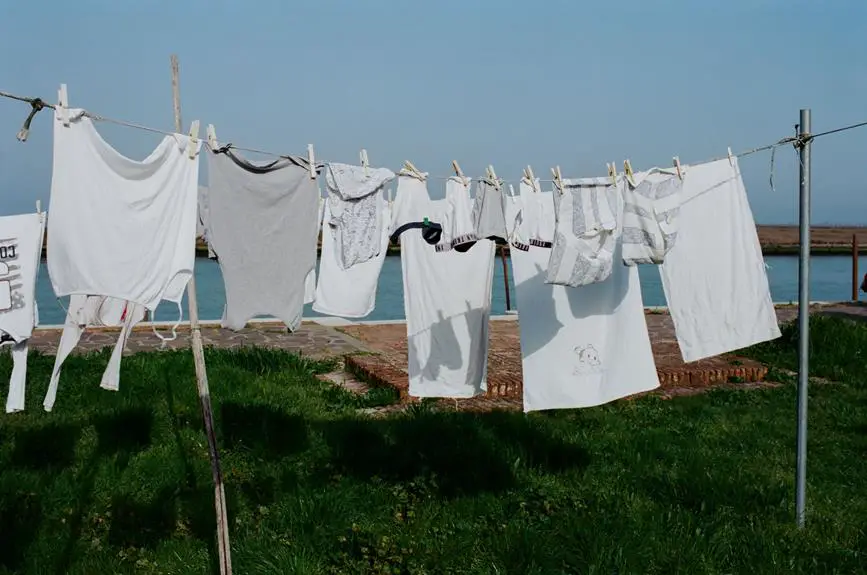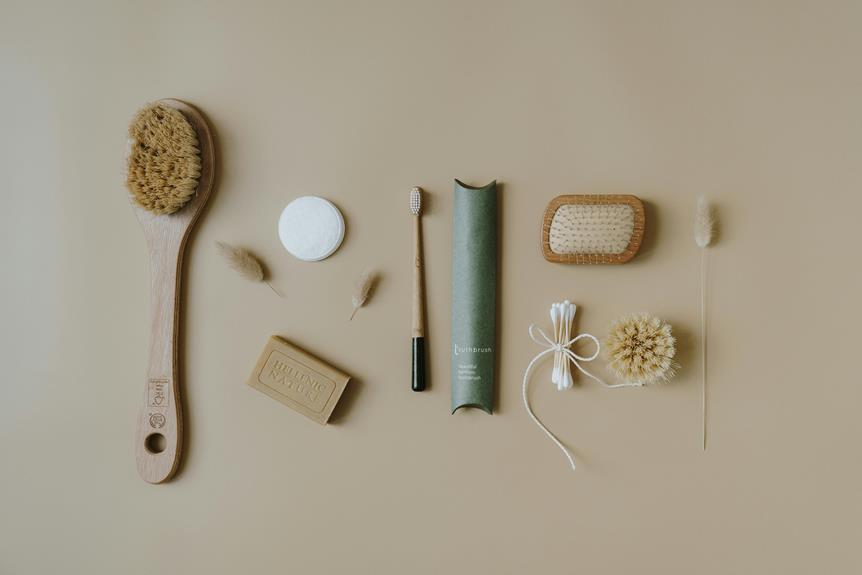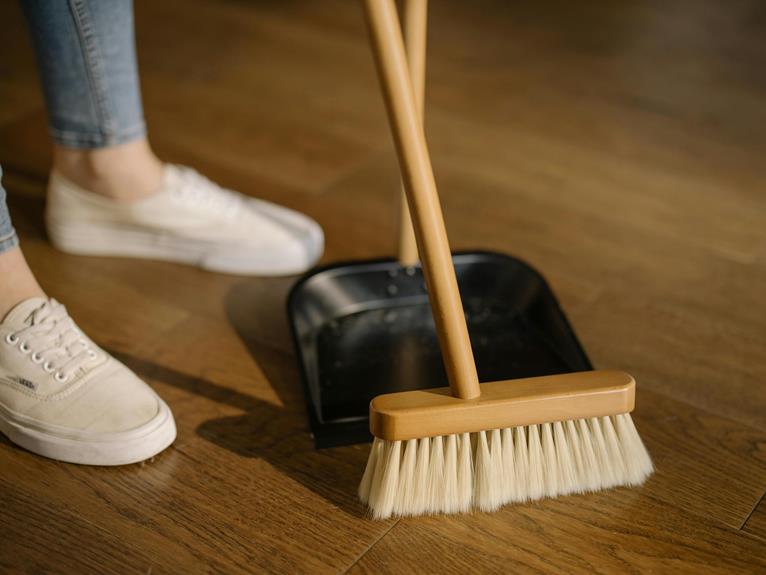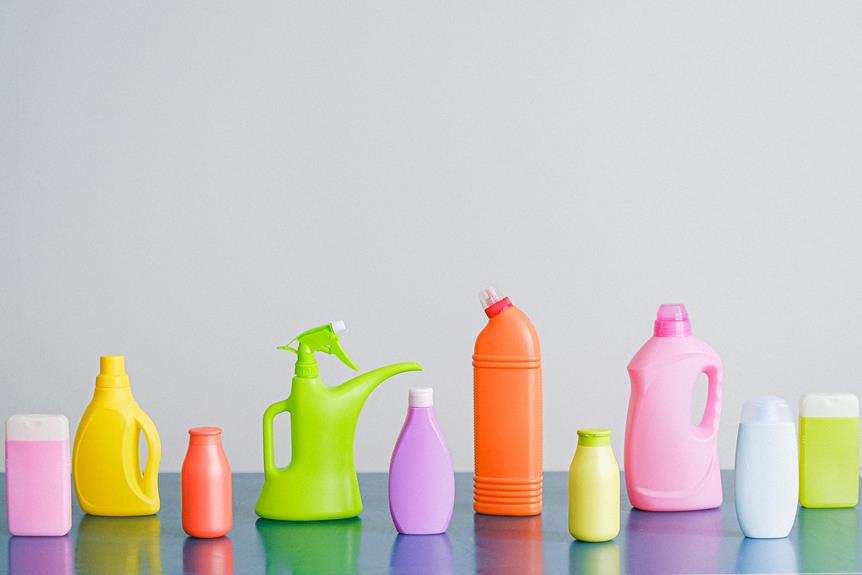When I started incorporating seasonal cleaning into my laundry routine, I was amazed at how much easier and more efficient it became.
One of the first things I did was deep clean my washing machine and refresh my laundry appliances, which made a noticeable difference in the cleanliness and freshness of my clothes.
But that’s just the beginning. Some other tips and tricks can help you streamline your laundry process and save time and energy.
Assess Your Laundry Space
Assess your laundry space by taking a moment to evaluate the layout and organization of your laundry area. Creating an efficient and functional laundry space is important for a smooth and enjoyable laundry routine.
Start by evaluating the available space and identifying areas that can be used for storage. Look for unused corners or walls where you can install shelves or cabinets, making it easy to keep your laundry supplies organized and within reach.
In addition to storage, consider the lighting in your laundry area. Good lighting is essential for tasks like sorting and folding clothes. If your current lighting isn’t sufficient, think about adding more light fixtures or upgrading to brighter bulbs to improve visibility and make your laundry tasks easier.
Another useful addition to your laundry space is a folding station. This can be as simple as a countertop or table where you can neatly fold your clothes. Having a dedicated area for folding won’t only make the task more efficient but also help keep your laundry area tidy and free of clutter.
Lastly, updating your appliances can greatly enhance the functionality and efficiency of your laundry space. Look for energy-efficient models that offer advanced features like larger capacity, shorter wash cycles, and smart technology. These updates will save you time and energy, making your laundry routine more enjoyable.
Remember to consider your specific needs and preferences when assessing your laundry space. By optimizing your storage, lighting, and appliances, you can create a laundry area that’s both practical and pleasant to use.
Declutter and Organize
To simplify and organize your laundry space, start by getting rid of any unnecessary items and sorting them into categories. Use these decluttering tips to create a functional and visually appealing laundry area.
Begin by going through your laundry supplies and discarding any expired or unused products. Consider donating or recycling items that are still in good condition but no longer serve a purpose in your laundry routine.
Once you’ve decluttered, it’s time to think about storage solutions and organizing hacks. Use shelves, baskets, and storage containers to keep everything neatly organized and easily accessible. Look for space-saving ideas like collapsible drying racks or wall-mounted ironing boards to maximize the use of your laundry area.
Embrace a minimalistic laundry routine to reduce clutter and create a more efficient space. Simplify your laundry process by streamlining your wardrobe, using multi-purpose products, and implementing efficient laundry systems.
Clean Out Your Laundry Supplies
Take a moment to go through your laundry supplies and remove any expired or unused products. Cleaning out your laundry supplies is an important step in maintaining a clean and efficient laundry routine. By decluttering and organizing your laundry supplies, you can create a more streamlined and enjoyable laundry experience.
To help you get started, here’s a handy table to guide you in assessing your laundry supplies:
| Category | Items to Check |
|---|---|
| Detergents | Check for expiration dates and discard any expired products. Also, consider donating unused detergents to local shelters or organizations in need. |
| Fabric Softeners | Inspect for expiration dates and get rid of any expired fabric softeners. Consider trying eco-friendly options for a more sustainable laundry routine. |
| Stain Removers | Check for expiration dates and dispose of any expired stain removers. You can also explore natural alternatives like vinegar or lemon juice for tackling tough stains. |
| Dryer Sheets | Remove any old or unused dryer sheets from your laundry supplies. Consider using reusable dryer balls as a more eco-friendly option. |
| Laundry Baskets | Take a moment to clean your laundry baskets and ensure they are in good condition. If needed, replace any worn-out or broken baskets for more efficient laundry organization. |
Sort and Purge Clothes
Organize your clothes and decide what to keep and what to get rid of. This is important for closet organization and creating a more efficient laundry routine. As you go through your wardrobe, consider the following:
- Donate clothes: Clear out items you no longer wear to declutter your space and help those in need. Donating clothes can give you a sense of fulfillment, knowing you’re making a difference.
- Storage solutions: Look for creative storage solutions to maximize your closet space. A well-organized closet makes it easier to find clothes and brings a sense of order to your home.
- Clothing maintenance: Take the time to sort through your clothes and identify any items that need repair or alteration. Investing in clothing maintenance can lengthen the lifespan of your garments and save you money in the long run.
- Sustainable fashion choices: Consider the environmental impact of your clothing choices. Opt for sustainable fashion options like buying second-hand or supporting brands that prioritize ethical and eco-friendly practices. Making conscious choices connects you to a community that values sustainability.
Deep Clean Your Washing Machine
Regularly maintaining and cleaning your washing machine is important for optimal performance and longevity. Taking the time to deep clean your machine not only ensures that your clothes come out fresh and clean, but it also helps to prevent common washing machine issues and saves energy.
Here are some methods to clean and maintain your washing machine:
- Run a hot water cycle: Running a hot water cycle without any clothes in the machine helps to remove built-up detergent residue and bacteria. This should be done regularly to keep your machine clean.
- Use vinegar and baking soda: Mix equal parts vinegar and baking soda and use this mixture to clean the drum and door seal of your machine. Vinegar helps to remove odors and baking soda acts as a natural deodorizer.
- Remove and clean the filter: The filter in your washing machine is responsible for catching lint and debris. It’s important to remove and clean the filter regularly to prevent clogs and improve drainage.
In addition to cleaning, here are some maintenance tips to keep in mind:
- Clean the detergent dispenser: The detergent dispenser can accumulate detergent residue, which can lead to mold and mildew. Clean it regularly to prevent buildup.
- Wipe down the drum and door seal: Moisture can get trapped in the drum and door seal, leading to mold and mildew growth. Wiping them down regularly with a damp cloth can help prevent this.
- Leave the door open after use: After each wash, leave the door of your washing machine open to allow air to circulate and prevent mold and mildew growth.
If you’re experiencing any issues with your washing machine, here are some troubleshooting tips:
- Check for water leaks: Inspect your machine for any signs of water leaks, such as puddles on the floor. This could indicate a problem with the water supply or drainage system.
- Ensure proper balance: If your washing machine is vibrating excessively or moving around during the spin cycle, it may be unbalanced. Make sure it’s level and adjust the feet if necessary.
- Clean the water inlet valve: If you notice a decrease in water flow or your machine takes a long time to fill, the water inlet valve may be clogged. Cleaning or replacing the valve can help resolve this issue.
To save energy, consider these energy-saving techniques:
- Use cold water for most loads: Heating water accounts for a significant portion of a washing machine’s energy usage. Using cold water whenever possible can help reduce energy consumption.
- Avoid overloading the machine: Overloading the machine can strain the motor and decrease its efficiency. Follow the manufacturer’s guidelines for load capacity to ensure optimal performance.
- Opt for shorter wash cycles when possible: Longer wash cycles use more energy. Choose shorter cycles that still effectively clean your clothes to save energy.
- Hang your clothes to dry instead of using the dryer: Air-drying your clothes instead of using the dryer can save a significant amount of energy. Plus, it helps to extend the lifespan of your clothes.
Inspect and Clean Dryer Vents
Regularly inspecting and cleaning your dryer vents is crucial for a smooth and efficient laundry routine. Neglecting this task can lead to issues that disrupt your laundry routine and pose safety risks.
Here are some important points to consider:
- Gather the necessary cleaning tools, such as a vacuum cleaner with a long hose attachment, a brush, and a screwdriver to remove the vent cover.
- Prioritize safety by unplugging the dryer and wearing protective gloves and goggles to prevent injuries.
- If you’re unsure about tackling the cleaning process yourself or encounter complex issues, consider hiring professional services.
- If you prefer a hands-on approach, there are DIY methods available. You can use a long brush to remove lint from the vent or a vacuum cleaner to suck out debris.
- Be aware of common issues like clogged vents, lint buildup, and damaged vent covers. Regular inspections and cleanings can help prevent these problems and maintain dryer efficiency.
Refresh Your Laundry Detergent
Improve your laundry routine by refreshing your laundry detergent. Not only will this help you achieve cleaner and fresher clothes, but it will also enhance your overall laundry experience.
One simple way to refresh your detergent is by adding a few drops of essential oils to your detergent bottle or directly into the washing machine. This will give your laundry a pleasant and long-lasting scent.
Another option is to switch to eco-friendly detergents that are better for the environment and gentler on your clothes. These detergents are made with natural ingredients and free from harsh chemicals.
In addition to refreshing the detergent itself, it’s important to store it properly. Keep your detergent in a cool, dry place to maintain its effectiveness. Avoid storing it in direct sunlight or a humid area, as this can cause the detergent to lose its cleaning power.
If you’re feeling adventurous, you can even try making your laundry detergent at home. There are plenty of recipes available online that use simple ingredients like soap flakes, washing soda, and borax. This not only saves you money but also gives you control over the ingredients used in your detergent.
For those looking for alternatives to traditional laundry detergents, consider using laundry balls or soap nuts. Laundry balls are reusable and contain ceramic beads that help remove dirt and odors from your clothes.
Soap nuts, on the other hand, are natural berries that contain saponin, a natural detergent. These alternatives aren’t only eco-friendly but also hypoallergenic, making them a great option for those with sensitive skin.
Find the Right Temperature Settings
Adjusting the temperature settings on your washing machine is important for optimal cleaning and care of your laundry. By choosing the right water temperature, you can ensure that your clothes aren’t only clean but also well-maintained.
Here are some energy-saving tips to help you make the most of your washing machine’s temperature settings:
- Benefits of Cold Water Washing: Washing your clothes in cold water saves energy and helps preserve the color and quality of your garments. This is especially beneficial for delicate fabrics and bright colors that may fade in hot water.
- Understanding Fabric Care Labels: Take a moment to read the fabric care labels on your clothes. They provide valuable information about the recommended water temperature for washing. By following these instructions, you can prevent damage to your garments and ensure they last longer.
- Maximizing the Use of Quick Wash Cycles: Quick wash cycles are designed to clean lightly soiled clothes in less time. By using these cycles, you can save energy and reduce water consumption while still achieving clean and fresh results.
- Energy-Saving Tips: Wash full loads whenever possible to maximize your washing machine’s efficiency. Additionally, using a high-efficiency detergent can help reduce the amount of energy and water needed for each wash.
Remember to follow these tips to optimize your washing machine’s temperature settings and save energy while keeping your clothes clean and well-maintained.
Optimize Your Laundry Loads
Make the most of your laundry loads by optimizing the amount of clothes you wash at once. This will help you save space, improve laundry organization, and increase efficiency.
To achieve this, here are some tips and hacks:
- Sort by Color: Separate your laundry into different piles based on color to prevent colors from bleeding onto each other. This will allow you to wash similar colors together and reduce the risk of ruining your clothes.
- Use a Mesh Bag: Before washing delicate items like lingerie and hosiery, place them in a mesh bag. This will protect them from getting tangled or damaged by other items in the load.
- Fill the Drum: Make sure to fill the washing machine drum, without overfilling it. This will maximize the use of water and detergent, resulting in more efficient cleaning.
Use Fabric Softener Wisely
To improve your laundry routine, it’s important to use fabric softener wisely. Here are some tips to help you maximize the benefits of fabric softener and achieve soft, fresh-smelling clothes every time:
- Use the right amount: Follow the instructions on the fabric softener bottle to ensure you’re using the correct amount. Using too much can leave residue on your clothes, while using too little may not give you the desired softness.
- Say goodbye to static: Fabric softener helps reduce static cling in your clothes, preventing those annoying shocks. No more embarrassing moments with your skirt sticking to your tights!
- Consider eco-friendly options: If you’re concerned about the environment, look for fabric softeners labeled as biodegradable or made from natural ingredients. These options are gentle on the planet.
- Try alternative methods: If you prefer to skip fabric softener altogether, there are other methods you can try. Adding a cup of white vinegar to your rinse cycle can naturally soften your clothes.
- Explore fabric softener alternatives: If you’re looking for alternatives to liquid fabric softener, consider using dryer balls or dryer sheets. These options can help reduce static and soften your clothes without the need for liquid fabric softener.
Check and Clean Your Dryer Filter
Make sure to clean your dryer filter regularly to ensure it works well and reduce the risk of fires. Cleaning the lint from your dryer filter is a simple but important step in keeping your laundry routine safe and efficient.
By removing the built-up lint, you can prevent fires and improve the airflow in your dryer, which will make it work better and dry your clothes faster.
Lint is highly flammable and can build up in your dryer filter over time. If you don’t clean it, it can catch fire. To prevent this, make it a habit to clean the lint from your dryer filter after every load of laundry. Just take out the filter, brush off the lint, and rinse it under running water. Let it dry completely before putting it back in the dryer.
Regularly cleaning your dryer filter not only reduces the risk of fires but also improves airflow in the machine. When the filter is clogged with lint, the air can’t circulate properly, which makes drying take longer and uses more energy. By keeping the filter clean, you allow the hot air to flow freely, which means your clothes will dry faster and you’ll save energy.
Clean Your Iron and Ironing Board
Regularly cleaning your iron and ironing board is essential for keeping them in good condition and ensuring optimal performance. Neglecting these important tools can result in a frustrating ironing experience and less-than-perfectly pressed clothes.
To make your ironing routine easier and more enjoyable, here are some tips for cleaning your iron and caring for your ironing board:
- Clean your iron: It’s important to regularly clean your iron to remove any residue or mineral deposits that may have built up. To do this, mix equal parts vinegar and water and use a soft cloth or sponge to gently scrub the soleplate. Then, wipe it clean with a damp cloth.
- Remove wrinkles effortlessly: To tackle stubborn wrinkles, make use of the steam function on your iron. Fill the water tank with distilled water to prevent mineral buildup, and press the steam button while ironing. The steam will penetrate the fabric, making it easier to remove wrinkles.
- Adjust heat settings: Different fabrics require different heat settings, so always check the care label on your clothes and adjust the temperature accordingly. Using the correct heat setting will prevent damage to your garments and ensure effective wrinkle removal.
- Protect your ironing board: To prevent scorching or staining your ironing board, place a clean, thick towel or a heat-resistant ironing board cover on top. This will provide a smooth and even surface for ironing.
- Store your iron properly: After use, allow your iron to cool down completely before storing it. Neatly wind the cord and keep the iron in a clean and dry place.
Remove Stains With Natural Remedies
Regularly maintaining your iron and ironing board is important. Now let’s explore how you can effectively remove stains using natural remedies. When it comes to tackling stubborn stains, there are eco-friendly and non-toxic alternatives that you can easily create using common household ingredients.
One of the most effective natural stain removal methods is using lemon juice. Simply squeeze fresh lemon juice onto the stained area and let it sit for a few minutes before washing as usual. Lemon juice works wonders on tough stains, such as grease or ink.
Another homemade stain remover is a mixture of baking soda and hydrogen peroxide. Create a paste by combining these two ingredients and apply it directly to the stain. Allow it to sit for a while, then rinse and wash as normal. This powerful combination is excellent for removing stains like coffee or red wine.
For oil-based stains, such as lipstick or butter, try using cornstarch. Sprinkle it on the stain, gently rubbing it in, and let it sit for a few hours. The cornstarch will absorb the oil, making it easier to wash away.
Freshen up Your Laundry Room
Create an inviting and refreshing laundry space with these simple tips.
Give your laundry room a fresh coat of paint in a calming color like soft blue or neutral gray. This will instantly brighten up the space and make it feel more welcoming.
Install shelves or cabinets to keep your laundry essentials organized and easily accessible. Having a designated place for detergent, fabric softener, and other supplies will make laundry day a breeze.
Upgrade your lighting fixtures to create a well-lit and energizing environment. Choose bright LED lights that mimic natural daylight to make your laundry room feel fresh and vibrant.
Add some personal touches to make your laundry room feel like a part of your home. Hang artwork or add decorative accents that reflect your style and personality. This will make the space feel cozy and inviting.
Consider replacing your old washer and dryer with energy-efficient models. Not only will this save you money on your energy bills, but it will also make your laundry routine more efficient and eco-friendly.
Create a Laundry Schedule
To maintain an efficient laundry routine, it’s important to create a laundry schedule that works for you. By prioritizing tasks and establishing a laundry routine, you can streamline your laundry process and manage multiple loads effectively. Time management is key to achieving an efficient laundry schedule.
Here are some tips to help you create and stick to a laundry schedule:
- Sort your laundry by color and fabric type. This will help prevent colors from bleeding and ensure that delicate fabrics are treated gently.
- Designate specific days for laundry tasks. For example, you can have one day for washing, another day for folding, and a third day for putting away clean clothes. This will help you stay organized and avoid overwhelming yourself with laundry all at once.
- Pre-sort clothes into separate hampers. Having separate hampers for whites, darks, and delicates will make it easier to sort your laundry quickly before washing.
- Plan your laundry around your schedule. If you know you have a busy day ahead, try to avoid scheduling laundry tasks for that day. Instead, choose a day when you have more time and energy to tackle the laundry.
- Pre-treat stains before washing. This will help ensure that stains are effectively removed during the wash cycle, saving you time and effort in the long run.
- Use laundry baskets to organize clean clothes. Instead of leaving clean clothes piled up in a hamper, use laundry baskets to separate and organize them by family member or room. This will make it easier to put away clean clothes quickly.
- Fold and put away clean clothes immediately. Avoid leaving clean clothes sitting around for too long, as they can become wrinkled and take up unnecessary space. Folding and putting away clothes as soon as they’re clean will help keep your laundry area tidy.
- Use a timer to prevent forgetting about a load. Set a timer when you start a load of laundry so that you don’t forget about it and leave it sitting in the washer or dryer for too long.
Maintain Your New Efficient Routine
Ready to maintain your efficient laundry routine? Keep these tips in mind:
- Organize your laundry supplies with storage bins or shelves for easy access.
- Save energy and extend garment lifespan by washing in cold water and air drying.
- Try laundry hacks like using vinegar as a fabric softener or adding tennis balls to the dryer.
- Keep your appliances in top shape by cleaning the lint trap and periodically deep cleaning.
- Stay consistent with your laundry schedule to avoid overwhelming piles.
By following these tips, you’ll keep your laundry routine running smoothly and efficiently. No more stress or wasted time searching for supplies or dealing with piles of laundry.
Conclusion
To sum up, seasonal cleaning is a game-changer for a more efficient laundry routine. By using essential tools, sorting and organizing effectively, and deep cleaning the washing machine, you can achieve fresh and odor-free clothes.
You can also save valuable time by updating and simplifying your laundry room setup, using time-saving laundry hacks, and properly storing and maintaining your laundry items.
Embrace the joy of a streamlined laundry routine and enjoy the benefits it brings.













